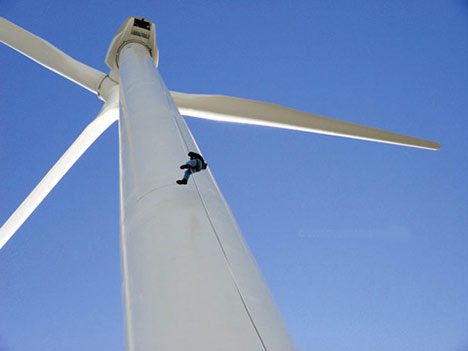According to a Swiss study, “the larger the (wind) turbine is, the greener the electricity becomes.” The study claims that for every doubling of the size of the turbine, “global warming potential per kWh (is) reduced by 14 per cent.”
The study was conducted by Marloes Caduff and his associates at the Zurich Institute of Environmental Engineering in Zurich, Switzerland.
Caduff et al. claim that there are two main reasons for the benefits of larger turbines. First, producers, now with decades of experience under their belts, are better at creating the massive blades, supports and motors. They “now have the knowledge, experience and technology to build big wind turbines with great efficiency.”
Second, recent advances in materials have allowed the turbines to dramatically increase in size without a corresponding increase in mass. That way, blades can be larger and capture much more wind while the tower and other parts can remain unchanged.
According to the researchers, the combined effects of these reasons allow for bigger and better turbines to be produced without using significantly more materials or drastically increasing transportation and assembly costs. The increased size of the turbines actually saves materials by reducing the number of total turbines needed to produce the same amount of power.
Wind energy is one of the fastest growing sources of energy on the planet and source of pride for alternative energy supporters. It now supplies about 2 per cent of global energy needs and that number could rise as high as 10 per cent by 2020. In the calender year 2011 alone , the global power capacity from wind increased by40,654 MW.
A recent study out of the UK indicated that the costs of off shore wind production could drop by up to one-third by the end of the decade.
If accurate, the study indicates that the general trend in the wind industry over the last 30 years has been the correct one.
In the 1970′s Vestas, the worlds leading wind manufacturer, released a turbine capable of producing 33KW of energy. The turbine had a blade diameter of 10 meters. Right now, Vestas’ top of the line turbine, an off shore model called the V164-7.oMW can generate, fittingly, 7.0 MW of energy and has a massive 80 meter blade length. The capacity for turbines like the V164-7.0MW has only developed recently and it seems certain that bigger and more powerful wind producers will be possible in the future.
The revelation that bigger is better in the world of turbine efficiency is bound to surprise some people. Paul Gipe, a wind expert and author of 7 books on the subject, was quoted a couple of years ago questioning the increased size trend: “The wind turbines don’t really need to get any larger. They’re big enough. There’s sometimes this obsession with going bigger and bigger and it’s not necessarily the size turbine that matters as much.”
According to Gipe, the most important developments in the history of wind power have been technological, things such as variable speed generation and electronics that allow engineers greater control, not blind increases in size. Now however, scientists and engineers have the ability to combine sophisticated controls and advanced technologies with absolutely massive turbines, thereby maximizing the efficiency and power generation from wind sources with a myriad of positive effects.
Max Frankel is a senior at Vassar College and an intern at the Center For American Progress
This article was originally published on Climate Progress – thinkprogress.org/climate. Reproduced with permission








